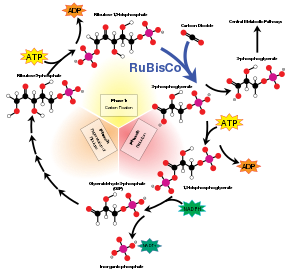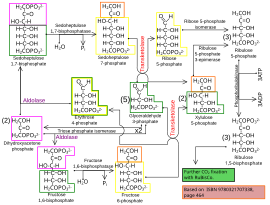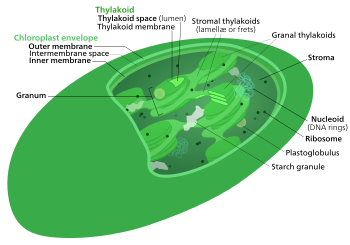Calvin cycle
TheCalvin cycle,light-independent reactions,bio synthetic phase,dark reactions,orphotosynthetic carbon reduction(PCR)cycle[1]ofphotosynthesisis a series of chemical reactions that convertcarbon dioxideand hydrogen-carrier compounds intoglucose.The Calvin cycle is present in all photosynthetic eukaryotes and also many photosynthetic bacteria. In plants, these reactions occur in thestroma,the fluid-filled region of achloroplastoutside thethylakoid membranes.These reactions take the products (ATPandNADPH) oflight-dependent reactionsand perform further chemical processes on them. The Calvin cycle uses the chemical energy of ATP andreducingpower of NADPH from the light dependent reactions to producesugarsfor the plant to use. These substrates are used in a series of reduction-oxidation (redox) reactions to produce sugars in a step-wise process; there is no direct reaction that converts several molecules of CO2to a sugar. There are three phases to the light-independent reactions, collectively called the Calvin cycle:carboxylation,reduction reactions, andribulose 1,5-bisphosphate(RuBP) regeneration.
Though it is also called the "dark reaction", the Calvin cycle does not actually occur in the dark or during night time. This is because the process requiresNADPH,which is short-lived and comes fromlight-dependent reactions.In the dark, plants instead releasesucroseinto thephloemfrom theirstarchreserves to provide energy for the plant. The Calvin cycle thus happens when light is available independent of the kind of photosynthesis (C3 carbon fixation,C4 carbon fixation,andcrassulacean acid metabolism (CAM)); CAM plants storemalic acidin their vacuoles every night and release it by day to make this process work.[2]
Coupling to other metabolic pathways
[edit]The reactions of the Calvin cycle are closely coupled to thethylakoidelectron transport chain,[3]as the energy required to reduce the carbon dioxide is provided by NADPH produced during thelight dependent reactions.The process ofphotorespiration,also known as C2 cycle, is also coupled to the Calvin cycle, as it results from an alternative reaction of theRuBisCOenzyme, and its final byproduct is anotherglyceraldehyde-3-Pmolecule.
Calvin cycle
[edit]This sectionneeds additional citations forverification.(December 2023) |

TheCalvin cycle,Calvin–Benson–Bassham (CBB) cycle,reductive pentose phosphate cycle (RPP cycle)orC3 cycleis a series ofbiochemicalredoxreactions that take place in thestromaofchloroplastinphotosyntheticorganisms.The cycle was discovered in 1950 byMelvin Calvin,James Bassham,andAndrew Bensonat theUniversity of California, Berkeley[4]by using theradioactiveisotopecarbon-14.[citation needed]
Photosynthesis occurs in two stages in a cell. In the first stage, light-dependent reactions capture the energy of light and use it to make the energy-storage moleculeATPand the moderate-energy hydrogen carrierNADPH.The Calvin cycle uses these compounds to convertcarbon dioxideandwaterintoorganic compounds[5]that can be used by the organism (and by animals that feed on it). This set of reactions is also calledcarbon fixation.The keyenzymeof the cycle is calledRuBisCO.In the following biochemical equations, the chemical species (phosphates and carboxylic acids) exist in equilibria among their various ionized states as governed by thepH.[citation needed]
The enzymes in the Calvin cycle are functionally equivalent to most enzymes used in other metabolic pathways such asgluconeogenesisand thepentose phosphate pathway,but the enzymes in the Calvin cycle are found in the chloroplast stroma instead of the cellcytosol,separating the reactions. They are activated in the light (which is why the name "dark reaction" is misleading), and also by products of the light-dependent reaction. These regulatory functions prevent the Calvin cycle from being respired to carbon dioxide. Energy (in the form of ATP) would be wasted in carrying out these reactions when they have nonet productivity.[citation needed]
The sum of reactions in the Calvin cycle is the following:[citation needed]
- 3CO
2+ 6NADPH+ 9ATP+ 5H
2O→glyceraldehyde-3-phosphate(G3P) + 6NADP++ 9ADP+ 8 Pi(Pi= inorganicphosphate)
Hexose(six-carbon) sugars are not products of the Calvin cycle. Although many texts list a product of photosynthesis asC
6H
12O
6,this is mainly for convenience to match the equation ofaerobic respiration,where six-carbon sugars are oxidized in mitochondria. The carbohydrate products of the Calvin cycle are three-carbon sugar phosphate molecules, or "triose phosphates", namely,glyceraldehyde-3-phosphate(G3P).[citation needed]
Steps
[edit]In the first stage of the Calvin cycle, a CO2molecule is incorporated into one of two three-carbon molecules (glyceraldehyde 3-phosphateor G3P), where it uses up two molecules ofATPand two molecules ofNADPH,which had been produced in the light-dependent stage. The three steps involved are:[citation needed]


- The enzymeRuBisCOcatalyses the carboxylation ofribulose-1,5-bisphosphate,RuBP, a 5-carbon compound, by carbon dioxide (a total of 6 carbons) in a two-step reaction.[6]The product of the first step is enediol-enzyme complex that can captureCO
2orO
2.Thus, enediol-enzyme complex is the real carboxylase/oxygenase. TheCO
2that is captured by enediol in second step produces an unstable six-carbon compound called 2-carboxy 3-keto 1,5-biphosphoribotol (CKABP[7]) (or 3-keto-2-carboxyarabinitol 1,5-bisphosphate) that immediately splits into 2 molecules of3-phosphoglycerate(also written as 3-phosphoglyceric acid, PGA, 3PGA, or 3-PGA), a 3-carbon compound.[8] - The enzymephosphoglycerate kinasecatalyses the phosphorylation of 3-PGA by ATP (which was produced in the light-dependent stage).1,3-Bisphosphoglycerate(glycerate-1,3-bisphosphate) andADPare the products. (However, note that two 3-PGAs are produced for everyCO
2that enters the cycle, so this step utilizes two ATP perCO
2fixed.)[citation needed] - The enzymeglyceraldehyde 3-phosphate dehydrogenasecatalyses thereductionof 1,3BPGA by NADPH (which is another product of the light-dependent stage).Glyceraldehyde 3-phosphate(also called G3P, GP, TP, PGAL, GAP) is produced, and the NADPH itself is oxidized and becomes NADP+.Again, two NADPH are utilized perCO
2fixed.[citation needed]

The next stage in the Calvin cycle is to regenerate RuBP. Five G3P molecules produce three RuBP molecules, using up three molecules of ATP. Since each CO2molecule produces two G3P molecules, three CO2molecules produce six G3P molecules, of which five are used to regenerate RuBP, leaving a net gain of one G3P molecule per three CO2molecules (as would be expected from the number of carbon atoms involved).[citation needed]


The regeneration stage can be broken down into a series of steps.
- Triose phosphate isomeraseconverts one of the G3P reversibly intodihydroxyacetone phosphate(DHAP), also a 3-carbon molecule.[citation needed]
- Aldolaseandfructose-1,6-bisphosphataseconvert a G3P and a DHAP intofructose 6-phosphate(6C). A phosphate ion is lost into solution.[citation needed]
- Then fixation of anotherCO
2generates two more G3P.[citation needed] - F6P has two carbons removed bytransketolase,givingerythrose-4-phosphate(E4P). The two carbons ontransketolaseare added to a G3P, giving the ketosexylulose-5-phosphate(Xu5P).[citation needed]
- E4P and a DHAP (formed from one of the G3P from the second
CO
2fixation) are converted intosedoheptulose-1,7-bisphosphate(7C) by aldolase enzyme.[citation needed]
- Sedoheptulose-1,7-bisphosphatase(one of only three enzymes of the Calvin cycle that are unique to plants) cleavessedoheptulose-1,7-bisphosphateintosedoheptulose-7-phosphate,releasing an inorganic phosphate ion into solution.[citation needed]
- Fixation of a thirdCO
2generates two more G3P. The ketose S7P has two carbons removed bytransketolase,givingribose-5-phosphate(R5P), and the two carbons remaining ontransketolaseare transferred to one of the G3P, giving another Xu5P. This leaves one G3P as the product of fixation of 3CO
2,with generation of three pentoses that can be converted to Ru5P.[citation needed] - R5P is converted intoribulose-5-phosphate(Ru5P, RuP) byphosphopentose isomerase.Xu5P is converted into RuP byphosphopentose epimerase.[citation needed]
- Finally,phosphoribulokinase(another plant-unique enzyme of the pathway) phosphorylates RuP into RuBP, ribulose-1,5-bisphosphate, completing the Calvincycle.This requires the input of one ATP.[citation needed]
Thus, of six G3P produced, five are used to make three RuBP (5C) molecules (totaling 15 carbons), with only one G3P available for subsequent conversion to hexose. This requires nine ATP molecules and six NADPH molecules per threeCO
2molecules. The equation of the overall Calvin cycle is shown diagrammatically below.[citation needed]

RuBisCOalso reacts competitively withO
2instead ofCO
2inphotorespiration.The rate of photorespiration is higher at high temperatures. Photorespiration turns RuBP into 3-PGA and 2-phosphoglycolate, a 2-carbon molecule that can be converted via glycolate and glyoxalate to glycine. Via the glycine cleavage system and tetrahydrofolate, two glycines are converted into serine plusCO
2.Serine can be converted back to 3-phosphoglycerate. Thus, only 3 of 4 carbons from two phosphoglycolates can be converted back to 3-PGA. It can be seen that photorespiration has very negative consequences for the plant, because, rather than fixingCO
2,this process leads to loss ofCO
2.C4 carbon fixationevolved to circumvent photorespiration, but can occur only in certain plants native to very warm or tropical climates—corn, for example. Furthermore, RuBisCOs catalyzing the light-independent reactions of photosynthesis generally exhibit an improved specificity for CO2relative to O2,in order to minimize the oxygenation reaction. This improved specificity evolved after RuBisCO incorporated a new protein subunit.[9]
Products
[edit]The immediate products of one turn of the Calvin cycle are 2 glyceraldehyde-3-phosphate (G3P) molecules, 3 ADP, and 2 NADP+.(ADP and NADP+are not really "products". They are regenerated and later used again in thelight-dependent reactions). Each G3P molecule is composed of 3 carbons. For the Calvin cycle to continue, RuBP (ribulose 1,5-bisphosphate) must be regenerated. So, 5 out of 6 carbons from the 2 G3P molecules are used for this purpose. Therefore, there is only 1 net carbon produced to play with for each turn. To create 1 surplus G3P requires 3 carbons, and therefore 3 turns of the Calvin cycle. To make one glucose molecule (which can be created from 2 G3P molecules) would require 6 turns of the Calvin cycle. Surplus G3P can also be used to form other carbohydrates such as starch, sucrose, and cellulose, depending on what the plant needs.[10]
Light-dependent regulation
[edit]These reactions do not occur in the dark or at night. There is a light-dependent regulation of the cycle enzymes, as the third step requires NADPH.[11]
There are two regulation systems at work when the cycle must be turned on or off: thethioredoxin/ferredoxinactivation system, which activates some of the cycle enzymes; and theRuBisCoenzyme activation, active in the Calvin cycle, which involves its own activase.[12]
The thioredoxin/ferredoxin system activates the enzymes glyceraldehyde-3-P dehydrogenase, glyceraldehyde-3-P phosphatase, fructose-1,6-bisphosphatase, sedoheptulose-1,7-bisphosphatase, and ribulose-5-phosphatase kinase, which are key points of the process. This happens when light is available, as the ferredoxin protein is reduced in thephotosystem Icomplex of the thylakoid electron chain when electrons are circulating through it.[13]Ferredoxin then binds to and reduces the thioredoxin protein, which activates the cycle enzymes by severing acystinebond found in all these enzymes. This is a dynamic process as the same bond is formed again by other proteins that deactivate the enzymes. The implications of this process are that the enzymes remain mostly activated by day and are deactivated in the dark when there is no more reduced ferredoxin available.[citation needed]
The enzyme RuBisCo has its own, more complex activation process. It requires that a specificlysineamino acid becarbamylatedto activate the enzyme. This lysine binds toRuBPand leads to a non-functional state if left uncarbamylated. A specific activase enzyme, calledRuBisCo activase,helps this carbamylation process by removing one proton from the lysine and making the binding of the carbon dioxide molecule possible. Even then the RuBisCo enzyme is not yet functional, as it needs a magnesium ion bound to the lysine to function. This magnesium ion is released from the thylakoid lumen when the inner pH drops due to the active pumping of protons from the electron flow. RuBisCo activase itself is activated by increased concentrations of ATP in the stroma caused by itsphosphorylation.[14]
References
[edit]- ^Silverstein, Alvin (2008).Photosynthesis.Twenty-First Century Books. p. 21.ISBN9780822567981.
- ^Cushman, John C. (2001)."A plastic photosynthetic adaptation to arid environments".Plant Physiology.127(4): 1439–1448.doi:10.1104/pp.010818.PMC1540176.PMID11743087.
- ^Sainis, Jayashree Krishna; Dani, Diksha Narhar; Dey, Gautam Kumar (2003-01-01)."Involvement of thylakoid membranes in supramolecular organisation of Calvin cycle enzymes inAnacystis nidulans".Journal of Plant Physiology.160(1): 23–32.doi:10.1078/0176-1617-00849.ISSN0176-1617.
The results suggested that the integrity of thylakoid membranes may be essential for the organisation of sequential enzymes of the Calvin cycle in vivo and facilitate their functioning.
- ^Bassham J, Benson A, Calvin M (1950)."The path of carbon in photosynthesis"(PDF).J Biol Chem.185(2): 781–7.doi:10.2172/910351.PMID14774424.Archived fromthe original(PDF)on 2009-02-19.Retrieved2013-07-03.
- ^Campbell, Neil A.; Brad Williamson; Robin J. Heyden (2006).Biology: Exploring Life.Boston, Massachusetts: Pearson Prentice Hall.ISBN0-13-250882-6.
- ^Farazdaghi H (2009). "Modeling the Kinetics of Activation and Reaction of Rubisco from Gas Exchange".Photosynthesis in silico.Advances in Photosynthesis and Respiration. Vol. 29. pp. 275–294.doi:10.1007/978-1-4020-9237-4_12.ISBN978-1-4020-9236-7.
- ^Lorimer, G.H.; Andrews, T.J.; Pierce, J.; Schloss, J.V. (1986)."2´-carboxy-3-keto-D-arabinitol 1,5-bisphosphate, the six-carbon intermediate of the ribulose bisphosphate carboxylase reaction".Phil. Trans. R. Soc. Lond. B.313(1162): 397–407.Bibcode:1986RSPTB.313..397L.doi:10.1098/rstb.1986.0046.
- ^Campbell, and Reece Biology: 8th Edition, page 198. Benjamin Cummings, December 7, 2007.
- ^Schulz, L; Guo, Z; Zarzycki, J; Steinchen, W; Schuller, JM; Heimerl, T; Prinz, S; Mueller-Cajar, O; Erb, TJ; Hochberg, GKA (14 October 2022)."Evolution of increased complexity and specificity at the dawn of form I Rubiscos".Science.378(6616): 155–160.Bibcode:2022Sci...378..155S.doi:10.1126/science.abq1416.PMID36227987.S2CID252897276.
- ^Russell, Wolfe et al.Biology: Exploring the Diversity of Life.Toronto:Nelson College Indigenous,1st ed, Vol. 1, 2010, pg 151
- ^Schreier, Tina;Hibberd, Julian(1 March 2019)."Variations in the Calvin–Benson cycle: selection pressures and optimization?".Journal of Experimental Botany.70(6) (published 27 March 2019): 1697–1701.doi:10.1093/jxb/erz078.PMC6436154.PMID30916343– via Oxford Academic.
- ^Konwarh, Rocktotpal; Abda, Ebrahim M.; Haregu, Simatsidk; Singh, Anand Pratap (2022-01-01), Khan, Raju; Murali, S.; Gogoi, Satyabrat (eds.),"Chapter 7 - Exemplary evidence of bio-nano crosstalk between carbon dots and plant systems",Carbon Dots in Agricultural Systems,Academic Press, pp. 155–173,ISBN978-0-323-90260-1,retrieved2023-04-22
- ^Besse, I; Buchanan, B (1997). "Thioredoxin-linked animal and plant processes: the new generation".Bot. Bull. Acad. Sin.38:1–11.
- ^Ruuska, Sari A.; Andrews, T. John; Badger, Murray R.; Price, G. Dean; von Caemmerer, Susanne (2000-02-01)."The Role of Chloroplast Electron Transport and Metabolites in Modulating Rubisco Activity in Tobacco. Insights from Transgenic Plants with Reduced Amounts of Cytochrome b/f Complex or Glyceraldehyde 3-Phosphate Dehydrogenase".Plant Physiology.122(2): 491–504.doi:10.1104/pp.122.2.491.ISSN1532-2548.PMC58886.PMID10677442.
- Bassham JA (2003). "Mapping the carbon reduction cycle: a personal retrospective".Photosynth. Res.76(1–3): 35–52.doi:10.1023/A:1024929725022.PMID16228564.S2CID52854452.
- Diwan, Joyce J. (2005)."Photosynthetic Dark Reaction".Biochemistry and Biophysics, Rensselaer Polytechnic Institute. Archived fromthe originalon 2005-03-16.Retrieved2012-10-24.
- Portis, Archie; Parry, Martin (2007)."Discoveries in Rubisco (Ribulose 1,5-bisphosphate carboxylase/oxygenase): a historical perspective"(PDF).Photosynthesis Research.94(1): 121–143.doi:10.1007/s11120-007-9225-6.PMID17665149.S2CID39767233.Archived fromthe original(PDF)on 2012-03-12.
Further reading
[edit]- Rubisco Activase, from the Plant Physiology Online websiteArchived2009-02-18 at theWayback Machine
- Thioredoxins, from the Plant Physiology Online websiteArchived2008-06-16 at theWayback Machine
External links
[edit]- The Biochemistry of the Calvin Cycle at Rensselaer Polytechnic Institute
- The Calvin Cycle and the Pentose Phosphate PathwayfromBiochemistry,Fifth Edition by Jeremy M. Berg, John L. Tymoczko and Lubert Stryer. Published by W. H. Freeman and Company (2002).

